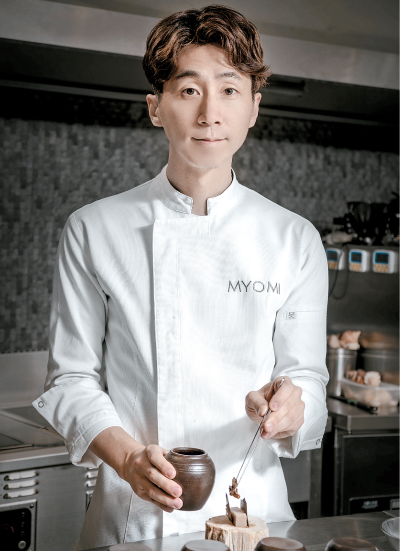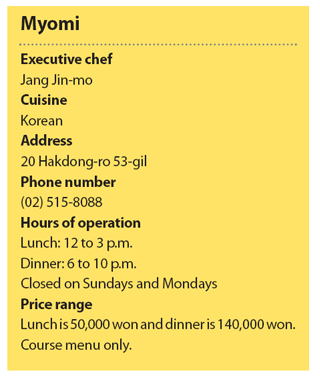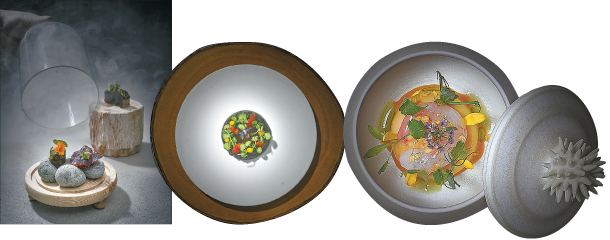Referencing history to go beyond ‘delicious’

Chef Jang Jin-mo of Myomi, above, plates a dish at his restaurant in Gangnam District, southern Seoul. At Myomi, he tries to serve his own versions of Korean recipes from past and present in order to remember styles of Korean food that were forgotten during the Korean War. Left are some of the dishes served at the restaurant. [MYOMI]
“No matter what you do, doing just tasty food won’t get you anywhere,” said Jang, adding that making great dishes gives you more power to confidently assert the ideas chefs have, but making something fit to what’s generally considered “delicious” should never be a goal, as everyone has different tastes.
“How could a chef who only goes for what’s tasty be [audacious] enough to change the world?”
Because he convinced himself that cooking is something he wants to do for life rather than just a means to support himself financially after trying careers in engineering and photography, the approach he takes is different.
He traveled across Europe to try eating at world famous restaurants, including The Fat Duck in Britain, and stayed for a couple of days in the kitchens if he could. He got his start washing dishes at a resort in Whistler, British Columbia.
To him, finding a purpose through his career was important. His international trips took him to Attica in Australia, where he found a reason to stay in the field.

“I came to realize that ideas - even philosophical ones - can be expressed through food, and this job could be what inspires me to continue to talk about what is in my brain,” said Jang.
After he did more contemporary cuisine with previous restaurant A&ND Dining, which closed in 2016, he opened Myomi in October to focus on revisiting Korean food. He looked through old recipe books to find previous forms Korean dishes or foods that were popular outside of Seoul to the capital city and filled the menu at Myomi with those items.
The idea to present his own version of Korean food came during a trip to New York, about the time that A&ND Dining was coming to an end. Based on his research and talks with chefs who run restaurants known for their distinct identities, he learned that persistence is key.

“If you want to be at a special place not everybody reaches, either you really do top quality food for all, or you do what’s yours persistently and refine it whether customers show immediate responses or not.”
While he has changed the order that certain dishes are served, especially rice dishes, and updated the ingredients he uses and recipes he studies, Jang hasn’t lost sight of bigger picture.
He serves a soup served by the royal family 200 years ago to welcome officials from overseas with vegetables that are sliced and put together in line to infuse the idea he wants to present to a level diners will also find interesting.
“Going back in culinary history, I find a lot of ingredients we now may think are foreign were used to make royal food back then,” said the chef. “What I want to do is to bring back what was used to the present because Korea’s food scene got disconnected to some level as the country went through the Korean War. Enjoying food was thought to be something obnoxiously luxurious right after the war when everybody just wanted the bare minimum to fight hunger.”
Besides time traveling to learn more about Korean food, he also works on developing dishes that only Myomi can offer.
This requires Jang to travel often to discover new ingredients that have not made it to Seoul, or are only produced in small quantities.
“Not holding on to a knife all the time or a pan in the kitchen doesn’t make a chef any less of a chef,” said Jang, adding that adequate directing could put the soul of the chef into the food without them literally cutting a zucchini into slices. “The important thing is to present the whole idea.”
While he develops his Korean food ideas at Myomi, he also plans to have a broader perspective by serving more casual a la carte dishes by collaborating with wine bar Les Clefs de Crystal, also in Gangnam District.
BY LEE SUN-MIN [summerlee@joongang.co.kr]










with the Korea JoongAng Daily
To write comments, please log in to one of the accounts.
Standards Board Policy (0/250자)